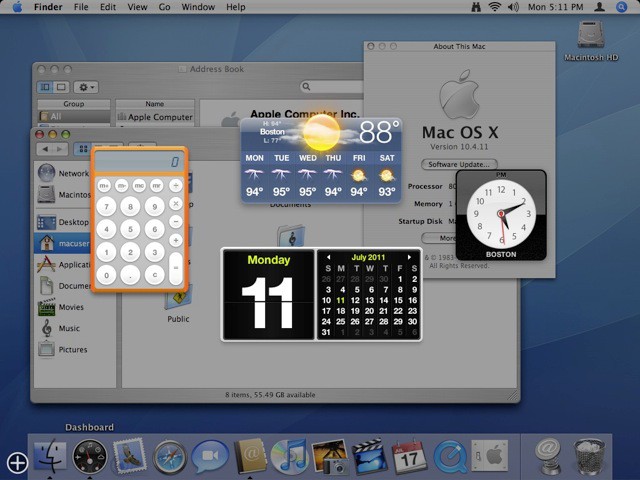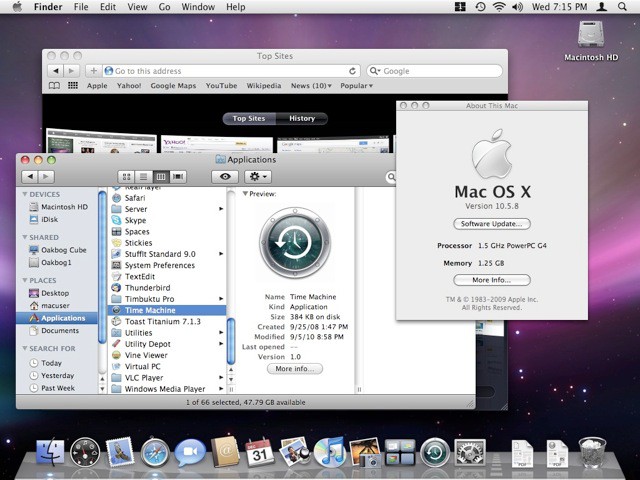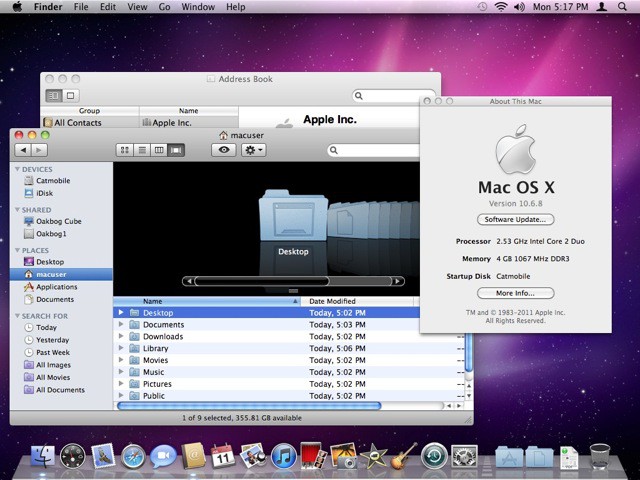Mac OS X 10.4 “Tiger” (2005)

Apple’s next big cat spent the longest time on the prowl of any Mac OS X release to date. Tiger spent about two and a half years on the market and spanned the Mac’s transition from PowerPC to Intel processors. After this release Apple slowed down rate of OS X upgrades to no more than once every 18 months, largely at the request of developers who were having trouble keeping up.
10.4 introduced Dashboard to the masses – similar to Desk Accessories from the Classic Mac OS – and replaced Sherlock Find with the heavily hyped Spotlight. The latter was a mixed blessing under Tiger, definitely a rev 1 release, but pointed the way to the future for Apple. As Spotlight and search capabilities in general evolve they are replacing the filesystem as the primary way we locate information on our computers.
Tiger was the last release which supported Classic mode on PowerPC Macs. As the first release for Intel systems Apple introduced Rosetta, a translation layer to allow old PowerPC code to run on Intel chips. Automator, Core Image and Core Video joined the arsenal of underlying technologies, and Brushed Aluminum dominated the interface.
Mac OS X 10.5 “Leopard” (2007)

Leopard is Apple first (and only) Universal Binary release of OS X, it can be installed from a retail installer on either Intel and PowerPC Macs. The OS was a major rewrite, fully supporting 64-bit applications, recompiling major routines for Intel, and dropping Classic mode support.
Time Machine backup software debuted with 10.5, offering an easy (and mostly reliable) way to backup your Mac with a very slick user interface. The outer space theme also became dominant on the desktop and login screen. Spotlight finally became truly useable, the Boot Camp utility to install Windows on your Mac was included (this was a beta download under Tiger), and the virtual desktop utility Spaces was introduced.
A subtly-shaded gray theme replaces brushed aluminum under Leopard. Safari continued its evolution, becoming an internet standard on Macs and iOS devices, and gains the Top Sites window. And the iTunes icon turned blue again…
Mac OS X 10.6 “Snow Leopard” (2009)

Snow Leopard was the Mac’s first Intel-only release, dropping support for PowerPC machines. It was billed by Apple as a maintenance upgrade to Leopard: no major features, just under-the-hood improvements. Underscoring Apple’s desire to get users to move to this release, the usual $129 price was dropped to $29.
Features and benefits are evolutionary. The Finder (finally) gets rewritten as a Cocoa app, MS Exchange Support is added to Mail, and the trackpad comes to desktop Macs. The full suite of iLife apps gets prime placement in the Dock, along with the new (and surprisingly controversial) iTunes icon.
Noticeably different to longterm Mac users is how the filesystem continues to get deprecated relative to search: the boot disk (internal hard drive) no longer appears on the desktop by default. And of interest to long time Mac users, Snow Leopard was the final OS X release that can run Power-PC software on Intel Macs (thanks to Rosetta). That makes this version a milestone for backwards compatibility.
Snow Leopard was a very capable, comprehensive release which powered the Mac’s strongest period of growth to date. Under Lion, among other changes, search becomes the primary way the Finder encourages you to interact with your system, and browsing hard drives becomes secondary. Apple has been trying to kill off the filesystem for years, have they finally succeeded? iOS leads the way.
Next: Lion and Mountain Lion
![Cats On The Prowl: The Evolution of Mac OS X From Cheetah To Mountain Lion [Gallery] evolutionlion](https://www.cultofmac.com/wp-content/uploads/2011/07/evolutionlion.jpg)

